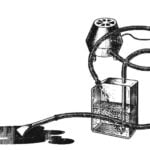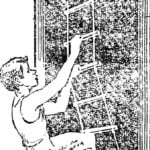 (The end. Start at # 1 ’03)
(The end. Start at # 1 ’03)
The CANBERRA bomber is an all-metal monoplane with a mid-wing and single-fin tail. The fuselage — semi-monocoque circular cross-section, consists of three parts: fore, middle (with the attachment of the center section and bomb Bay) and tail. The fuselage skin riveted “wpoty”. Sealed cockpit and Navigator situated in the nose of the fuselage. Cabin pressure is automatically controlled; the temperature sets the pilot. The canopy is molded from two layers of clear Plexiglas; between the layers circulating dry heated air tapped from the engine compressor.
Armchair Navigator located behind the pilot’s seat on versions V. 1, V. 2, V. 6 and ahead — V. 8. Both seat ejection. Above the navigation station in the fuselage there is an emergency hatch. Fold hatch of the bomb Bay opening to clean the inside of the fuselage, gliding on rollers in curved guides. Actuator valves — hydraulic.
A wing with aspect ratio of 4.3 has a symmetrical profile with a relative thickness of 12% at a root and 9 on the ends. Detachable console attached to the center section using the nodes on the main spar and the rear auxiliary spar-wall. The stringers are attached to the wing ribs of a small uskovym bolts. Flaps located on the wing portions on both sides of the nacelles are controlled hydraulically.


Experienced bomber CANBERRA(1).8:
1 — the tail cowl of the fuselage; 2 — trimmer of the rudder; 3 — maintenance flap control system; 4 — keel; 5 — the tail section of the fuselage; 6 — the filler caps of fuel tanks; 7 — wing external fuel tanks (PTB); 8 — filler cap PTB; 9 — the canopy pilot; 10 — ejection seat; 11 — canopy of canopy; 12— cabin Windows of the operator; 13— LDPE; 14 hood compartment fire extinguishers; 15 — hatch operator cab; 16— hatches compartments of electrical equipment; 17 — hatches compartments aerodrome power supply; 18— battery hatch; 19 — internal cannon container; 20 — antenna radar altimeter; 21 — tail safety heel; 22 — Horny compensator rudder; 23— hatch compartment photographic equipment; 24 — Central section of the fuselage; 25 — the bow section of the fuselage; 26—flaps wheel wells of the main landing gear; 27 — fold wheel wells of the a-pillar; 28: rib; 29 — lug-bolt; 30 — stringers; 31 —front suspension; 32—front wheel; 33 — wing pylon; 34 — cook (Central body); 35 — grid air discharge; 36 maintenance access doors control system; 37 — air brake; 38— output device (nozzle) of the motor; 39 — maintenance hatch compartment photographic equipment; 40 — Horny compensator rudder; 41 —the steering wheel height; 42 — trimmer of the Elevator; 43 — stabilizer; 44 trimmer Aileron; 45 — rejected on the ground plate-trimmer; 46–ailerons; 47 — ANO; 48 — input device of the engine (air intake); 49 — glass compartment of the equipment; 50 —brake flaps; 51 companies outlets; 52 — site installation of weapons pylons; 53—the shield stands the main wheels; 54—dvuhsvetny front; 55 — a front wheel axis; 56— the rod of the absorber of the front rack; 57— cylinder retract main landing gear; 58 — node linkage wheel main landing; 59— wheel main landing; 60 — earring of fastening of the tow rope; 61 — the main strut; 62 — lock the retracted position of the front pillar; 63 — thrust fold-front niches; 64 — Podramagi mechanism; 65 — pin opening of the valves; 66— axle mounting of the front pillar; 67 — mud flap; 68 — niche-pillar; 69 — engines; 70 — niches of cleaning the wheels of the main stand
Brake pads top and bottom of the wing, consisting of individual profiles, channel cross sections, are deflected vertically upward and downward with rotation against the flow, speaking thus at the surface of the wing 305 mm. for the Ailerons with a spring controlled compensators and trimmers.
The stabilizer can be deflected in flight from the neutral position up and down 1°52‘ electric. The Elevator has a spring compensator and controlled trimmer. On rudder trimmer driven; in addition, there is an actuator which automatically deflects the rudder when the thrust asymmetry of the engines. Harness control the rudders and ailerons hard.


Serial bomber CANBERRA B. 2:
1 — radio transparent fairing; 2 — open the window; 3 — the canopy pilot; 4 — headrest of the ejection seat; 5,30 —glazing emergency hatch of the escape cabin of the Navigator; 6 — escape hatch; 7 — cabin Windows of the Navigator; 8 — operating hatch; 9 — operational hatches compartment electronic equipment; of 10.57 — ejection seat; 11 — hatch compartment aerodrome power supply; 12—radiotransparent Radome of the radar; 13— the first side rail; 14 — a main spar; 15 — rear spar; 16 — a niche of the brake flap; 17 — rudder; 18 — cabin Windows, Bombardier; 19 — the filler caps of fuel tanks; 20 — PTB; 21 — antenna radios; 22 — rejected on the ground plate-trimmer; 23 trimmer of the rudder; 24 — antenna radar altimeter; 25 — Luke backup starter engines; 26— glazing-chamber equipment; 27 — sash bombolyuka: 28 — battery hatch; 29 — LDPE; ZI — hatch in the cockpit; a 32 — fold niche nose landing gear, the 33 — front wheel; 34 maintenance hatch; 35 — fold wheel wells of the main stand; 36— wheel main landing; 37 — the flap of the main stand; 38 — safety heel; 39 — dimensional tail lamp; 40 the root rib of the stabilizer; 41 — rib of the rudder; 42 — spars keel; 43 — rib of the keel; 44 — actuator rudder angle of installation of the stabilizer; 45 frames of the fuselage: 46 — stringers; 47 — pipe emergency drain fuel; 48— power sealed bulkhead; 49—second fuselage fuel tank; 50 — power sealed bulkhead-the bulkhead; 51 — the first fuselage fuel tank; 52 — air balloon, 53 — hermetic bulkhead of the first fuel tank; 54—oxygen tanks; 55 — hardware autopilot; 56 — power frame; 58 — devices Navigator; 59 — the tube of the radar screen; 60 — left panel of the dashboard; 61 — the control wheel; 62—dashboard; 63 — pedal foot control; 64—seat Bombardier in the bombing; 65 — communication equipment; 66 — bombsight; 67 — cabin floor; the 68 — unit radio and electrical equipment; 69— front suspension; 70 — mudguard; 71 — niche of the front pillar; 72 is a bomb Bay; 73 — 500-pound bombs; 74—camera, 75 — emergency backup starter; 76 — floor of the tail section; 77—pull rudder stabilizer; 78 — stabilizer; 79 Kil; 80 — niche main landing gear; 81 engine; 82 — brake pads in the released position; 83—thrust of the brake flaps; 84 — rocking thrust of the brake flap; 85 — flange rocking; 86 — pull mechanism to open the bomb Bay leaf; 87 — rocking chair sash bombolyuka; 88 — cylinder; 89 — housing of the hydraulic drive; 90 — handlebar height; 91 — trimmer of the Elevator; 92 maintenance hatch compartment equipment; 93 — brake pads in the retracted position; 94— 1000-pound bomb; the 95 — unit with 37 Nursi caliber 51 mm; 96 — a modified wing pylon; 97 — APU; 98 — a guided missile AS.30; 99— output device (nozzle); 100 frames; 101—extension flame tube; 102 combustion chamber; 103 — housing of the compressor; 104 — a Central body (CCO) of the engine; 105 — cowl; 106 blocks fuel control; 107 — power fire frame

Main landing gear of the firm English Electric retracts in the wing between the engine nacelles and the fuselage. Depreciation of fixed racks oil-air. Wheels fitted with pneumatic brakes; later they were replaced by hydraulic. Double oriented and self-aligning the front wheel retracts into the compartment of the fuselage, located in front of the pressurized cabin. Shock it rack melanoplinae. The actuator of the landing gear electro-hydraulic.
Turbojet engine is mounted ahead of the main spar on the reinforced ribs.
The generators are the mains and the pumps of the hydraulic system installed on an aggregate boxes both engines under the compressors. The grid of plane — the DC voltage of 24 V.
Flight characteristics of the bomber CANBERRA, V. 2:
Wing span, m………………………………………………………….19,5
Length of aircraft, m…………………………………………………….20,19
The height of the aircraft, m ……………………………………………………4,77
Wing area, m2……………………………………………………. 89,2
Tail plane area, m2……………………….15,9
Vertical plane area, m2…………………………..6,62
Length of the root chord of the wing, m…………………………………..5,79
Terminal length of the chord of the wing, m…………………………………..2,34
The scope of the horizontal tail, m……………………………8,35
Length of the root chord of the horizontal tail, m…….3,05
Terminal length of the chord of the horizontal tail, m…….1,22
Cross-V of the horizontal tail, degrees ………………10
Cross-V center section of the wing, degrees……………………………2
Cross V wing panels, hail…………………………….4,21
The installation angle of the wing, degrees………………………………………..2
Wheel track, m……………………………………………………………4,70
Weight, kg:
empty aircraft………………………………………………….. 10 070
maximum takeoff…………………………………………20 866
The supply of fuel in internal tanks, l…………………… 11 169,5
Outboard wing tanks, l……………………………….2×1109,2
Type engines……………………..Rolls-Royce Avon RA.7 Mk.109
Link unforced kg………………………………………. 2×3360
Maximum speed, km/h:
at the altitude of 12 000 m…………………………………………………….870
at sea level…………………………………………………………830
Practical range, km ………………………………………. 5840
Combat radius of action, km……………………………………….1300
The maximum rate of climb, m/min… ………………..1036
Practical ceiling, m…………………………………………. 14 630
Small arms………four 20-mm cannon Aden Mk.4
with 500 rounds per gun
E>omnova load (in the bomb Bay and on two
external hardpoints), kg……………………………………. 3629
Options bomb load:
in the compartment………………..6×454 kg, 1×1814 kg and 2×454 kg, 9×227 kg;
on the external sling………… 2×454 kg, 2×227 kg, 2 UR AS.30
2 container with 7.62-mm machine guns, 2 units with 37 Nursi caliber 51 mm
N. Food reserve was, A. CHECHIN, Kharkov



